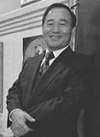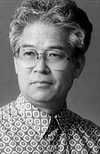|
A
large amount of worldwide companies sent its
work to Asian countries, although the name
of the facilities was not shown. In the early years, in
any case, they were only retakes or finishing works
on a limited number of episodes. Usually, all the drawings were then
shipped via sea in special containers and stored into huge archives
placed
all over California, ready-made for the post-production steps. |
|
|
In the late '70s, Taiwan's cartoon industry was still almost entirely
controlled by the Japanese. Motosuke Takahashi was one of the technical advisors in Taipei for Nippon Sunrise. Wang Film Productions (Hong Guang) was founded
by James Wang under the name Cuckoo's Nest Studio
in
1978. After a short time,
Steve Chen and Jack Jiang
became the
first draftsmen to be attracted by that new entrepreneur, this because
the Japanese works were discontinuous and there were frequent
off-seasons
in which they often were not busy anything. Shang·Shang
and his owner Mr. Cheng had big
troubles about it. Hsin Hong and Mei Xue
ran identical problems. Ying Ren Cartoon Centre,
represented by Chen Xin Hui, worked primarily for Tokyo
Movie under the strict overseeing of Daikichiro Kusube. China
Cartoon Productions, in conjunction with Toei of Japan, premiered a movie
named
"San Guo Yan Yi", but with no good result. Urged by William Hanna, Cuckoo's
Nest/Wang Film and its subsidiaries made most of the American TV shows seen up to 1985; the assignments from the United States turned
at
full
forces and there were no dead times. Yuan Dong, set
up in 1968
and better known out of the Asia as Far Eastern,
could be considered as the oldest and still active Taiwanese firm: after years of experimentation and educational stuff, it
started its OEM-works processing in-betweens for Hanna-Barbera (through
Wang Film) and opened a parent company at Wuxi in order to receive
works from Japan. |

James
Wang
|
|
John
Conning and Al Gaivoto were among the first supervisors to
travel in Taiwan and Seoul. Prior to Asia, Hollywood film majors
tried to make their works in Australia, Spain, Mexico and even Poland. That
expedient was kept hidden through the use of fictitious names. This
business strategy
was the main cause of numerous strikes from the
personnel of the American cartoons studios. |
|

Nelson
Shin |
The
animation industry had become firmly established in Seoul. Tayk Kim had
left Dong-seo in 1982 and moved at Take
One, a new facilitiy run by
Jerry Smith, a long-time friend of William Hanna. Take One
did most, if not all the fulfillment for Hanna-Barbera, Ruby/Spears,
SEPP and numerous foreign clients. By 1980, Steven Hahn operated with
his new agency in Los Angeles; Mi-Hahn signed an
important deal with
Marvel Group. AKOM Productions, the largest service
supplier in Seoul,
was quickly organized in 1985 by Nelson Shin. AKOM
was built on
Marvel's request, since Hanho Heung-up had
stipulated an exclusive
contract with Ruby/Spears. Hanho was launched by
Steven Hahn in 1984;
most of the staff came from Dong-seo. After Take
One bankruptcy (circa 1986),
Tae-Soo Kim and Larry Smith –a son of Jerry Smith–
founded Big Star to carry on the work for
Hanna-Barbera. Take One was bought out and, later
on, merged into Hyun Young Enterprises.
Those people of that dissolved company in Korea, at least certain
Americans of it, have then engaged new labor force in Canton and Hong
Kong; their animators were trained by Italian artist Fabio Pacifico in
order to start producing "Sebastian Star Bear", completed in 1991 after
five years of
hard work. At that point in time, Asia had a bunch of prolific
studios spread throughout Tokyo and South Korea as well as in the
Philippines. However, there were really a mere handful of names to be
remembered in
China. Shanghai itself had just a pair of renowned installations,
including Morning Sun (Chaoyang) and Shanghai
Animation Film Studio, which for decades produced chiefly
governmental propaganda
short-films. |
|
|
MOM Production (then renamed VideoTokyo)
was set up by the late foremost
puppet animator Tadahito Mochinaga; he's also among the people who
built the still existing Shanghai Animation Film Studio.
An other
Japanese stop-motion workshop was Yutaka Fujioka's Tokyo
Ningyo Cinema;
it's important because it will morph in Tokyo Movie
(today known as TMS
Entertainment). |
|
|
Even
while North Korea has been under US-led sanctions that include a ban on
commercial trade, several segments of US animated films have been
relocated to the country. Seoul's studios allegedly sub-contracted to
North Korea portions of the TV-series that they had originally received
from the United States. At the present day, only a few Japanese
producers outsource work in South Korea because of the increasing cost
of the job. Americans moved in the emerging Philippines, where Toei
established a steady and durable joint-venture with Engineering
Equipment Inc. (EEI). Marvel did some of its TV-series at
Burbank Films,
a Sydney based company with a division in Makati City (Metro Manila). Fil-cartoons,
managed by Jerry Smith, had a small separate unit to animate
TV-series for the Australian Disney's branch. Toei also did agreements
with Malaysian Lensa Film and Thai Kantana
Animation. Besides the regular support of Pyongyang's Studio
SEK,
France's Pixibox owns facilities in Ho Chi Minh, Vietnam. In addition,
Taipei's principal competitors continue to open a lot of smaller
service
studios in mainland China, with the intent only on securing cheap
labor. Accordingly, Bobby Hsieh, the president of Hong Ying
Universe,
moved its production arm at Suzhou and opened a new satellite studio in
Nanjing, keeping in Taiwan the sole administration board along with a
small core of layoutmen (as Hung Long Studio).
For the same reason, the Koreans are appraising
to inaugurate a future collaboration in Brunei. Also India is trying to
enter the entourage of the most greater Asia-Pacific players,
especially in the development of CGI and Flash segments. |

Tad
Mochinaga |
|
Disney Animation (Japan) Inc. was
founded in 1989 with the acquisition of Pacific Animation
Corp. (PAC)
and the recruitment of key members from the disbanded animation
department of Sanrio Film. New and more modern facilities were created
in 1991 and closed in the year 2004. Motoyoshi Tokunaga,
ex-TMS producer and Disney's top manager, forms his own
company
named The Answer Studio. |
|

Jung
Yul Song |
Between
1965 and 1968, Nobuhide Morikawa was sent at Seoul to aid the
apprenticeship of young animators in order to produce TV-series for
Daiichi Doga. Most of the present Korean animation directors initiated
there their career. It wasn't too long after Morikawa moved in Korea
that another start-up team began his operations. International-Art
(Guk
Je-Art), owned by J. H. Song and headed by Tayk Kim,
commenced re-doing
frame-by-frame a series of single reel shows –on changing b/w
film into color– featuring US classic characters
such as "Felix The Cat" and "Betty Boop".
After the abrupt closure of Color Systems in the United States, Mr. Kim
and his crew went on to do ink and paint work on behalf of Ralph
Bakshi. The job was brought there due to the insistence of Steven
Hahn, a Korean-born that lived and worked in America. In fact, he knew
very well the efforts of Tayk Kim, and that the procedures were more or
less the same ones of the previous recolorizing era. Andy Kim and Gil
Hwan Kim, respectively founders of Toon-Us In and Saerom,
grew professionally at the drawing desks of Miroh,
a pool of novice artists
put together by Fusahiro Nagaki around 1973-74. Jung Yul Song
(president and CEO of Sae Hahn) says that he was
employed at Se-Gyeong
in 1976. This company achieved OEM-works for Toei Doga under the
guidance of Jouji Kikuchi.
Finally, Se-Gyeong released "Dalyeora Majeonga-X",
a poor and unauthorized version of the
widely famous "Grendizer". During few years, certain Korean studios
turned out dozens of films with props and characters copied by the
anime counterparts. Daiwon and K.Production
obtained theirs first notable jobs for the Japanese market in 1978, and
there,
for the first time, Tokyo's main studios hands out the realization of
a number of key animations to the Korean manpower. |
|
|
RESUME
FOR
ITALIAN READERS  |
|
|

